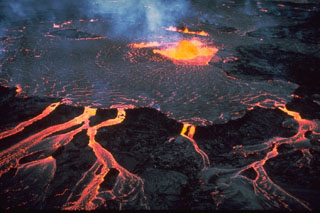Report on Kilauea (United States) — 18 June-24 June 2025
Smithsonian Institution / US Geological Survey
Weekly Volcanic Activity Report, 18 June-24 June 2025
Managing Editor: Sally Sennert.
Please cite this report as:
Global Volcanism Program, 2025. Report on Kilauea (United States) (Sennert, S, ed.). Weekly Volcanic Activity Report, 18 June-24 June 2025. Smithsonian Institution and US Geological Survey.
Kilauea
United States
19.421°N, 155.287°W; summit elev. 1222 m
All times are local (unless otherwise noted)
The Hawaiian Volcano Observatory (HVO) reported that the eruption within Kilauea’s Kaluapele summit caldera, characterized by episodic fountaining and intermittent spatter at two vents along the SW margin of Halema’uma’u Crater, continued at variable levels during 18-24 June. Nighttime incandescence at both the N and S vents and intermittent lava spattering at the N vent were visible during 18-19 June. Small, sporadic periods of spattering and intermittent overflows of lava began at the N vent at 2326 on 19 June. The activity intensified until 0140 on 20 June when lava fountains became sustained. By 0155 the fountain was 250 m tall, and lava was advancing on the crater floor; by 0210 the fountain was over 300 m tall. Lava fountaining at the S vent began at around 0200. The activity at the N vent continued to intensify and by 0326 the fountain at the N vent rose well over 305 m. The eruptive plume rose at least 6 km (20,000 ft) above ground level. Sulfur dioxide emissions were not directly measured, though typical values observed for past episodes of lava fountaining averaged 50,000-75,000 tonnes per day. Gas and tephra drifted S based on wind data from the National Weather Service. Lava flows from both vents covered parts of the crater floor. After about eight hours of continuous fountaining, the N vent stopped erupting at 1007, and the S vent stopped at 1025. Strong incandescence from both vents was visible overnight during 22-24 June. Data analysis revealed that the fountain from the N vent rose 380 m, a new height record for the current eruption. The Volcano Alert Level remained at Watch (the third level on a four-level scale) and the Aviation Color Code remained at Orange (the third color on a four-color scale).
Geological Summary. Kilauea overlaps the E flank of the massive Mauna Loa shield volcano in the island of Hawaii. Eruptions are prominent in Polynesian legends; written documentation since 1820 records frequent summit and flank lava flow eruptions interspersed with periods of long-term lava lake activity at Halemaumau crater in the summit caldera until 1924. The 3 x 5 km caldera was formed in several stages about 1,500 years ago and during the 18th century; eruptions have also originated from the lengthy East and Southwest rift zones, which extend to the ocean in both directions. About 90% of the surface of the basaltic shield volcano is formed of lava flows less than about 1,100 years old; 70% of the surface is younger than 600 years. The long-term eruption from the East rift zone between 1983 and 2018 produced lava flows covering more than 100 km2, destroyed hundreds of houses, and added new coastline.
Source: US Geological Survey Hawaiian Volcano Observatory (HVO)

